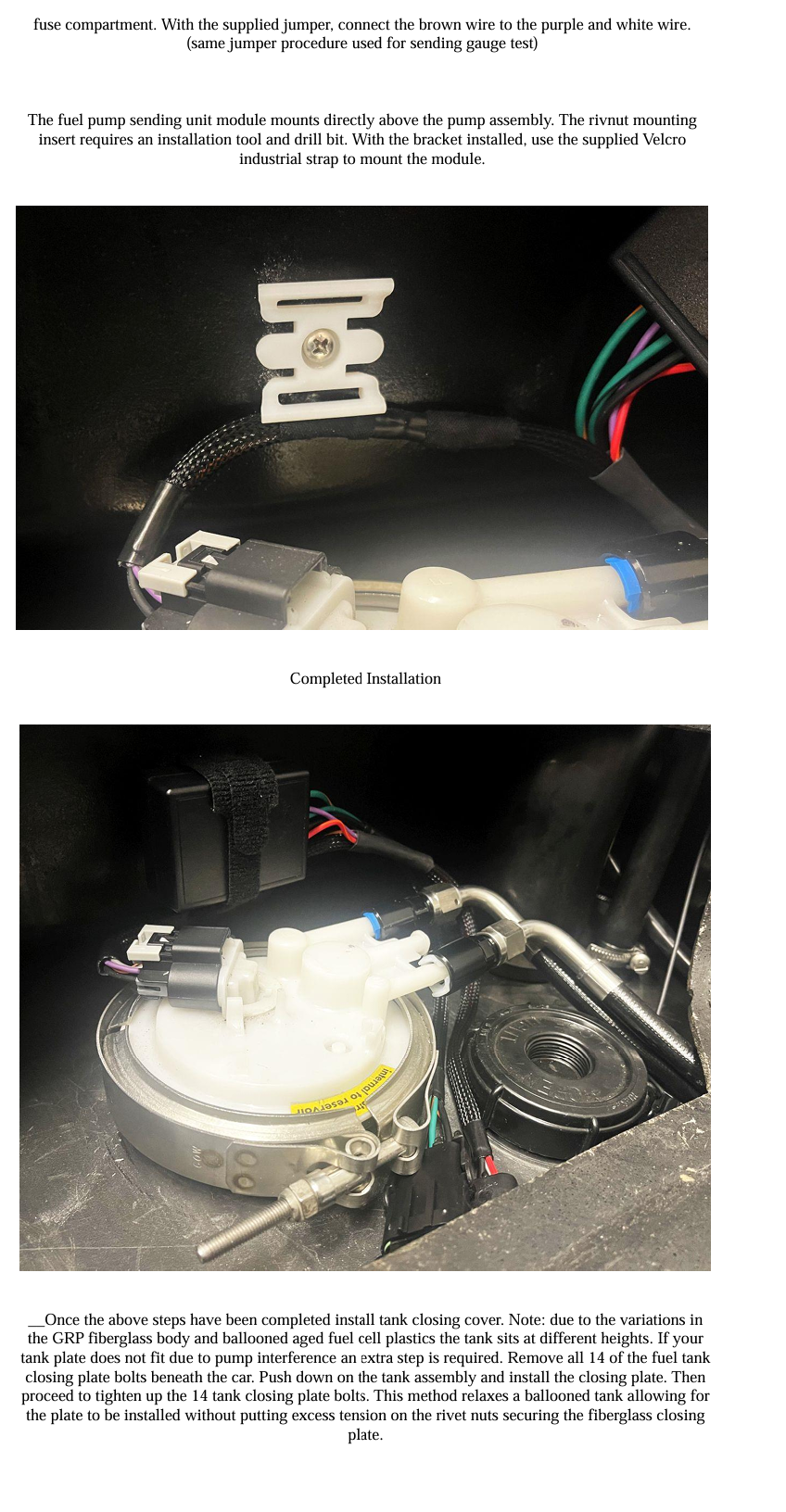02/22/2025 - Currently the only modern pump system available for the DeLorean. Fit's all models produced from 1981-83 (the only years the car was produced)
Product Description:
DeLorean Industries updated fuel pump configuration (GEN 4). Direct replacement for failure prone stock configuration. The system is based around a high quality Delphi pump unit meeting OEM manufactures who demand strict reliability standards. Originally released in 2010 with our SPEC EFI fuel injection solutions to combat ethanol blended fuel usage. Note that sub-standard knock off kits with low quality look alike components are often mistaken and misrepresented as the same quality as this system. Our product offering is only available directly from us and not available through third party retailers. Further more, the complex installation instructions should not be used as a guideline for any system other than this offering.
Additional Product Information:
Features/Differentiation, What's in the Box?, Component History & Engineering Solutions, Specifications, & Current Installation Instructions
Features and how this system differentiates from the rest?
__ Billet anodized -6 AN high flow one way check valve with 304L internals attached via stainless steel AN fittings.
__ Braided stainless steel feed and return lines with stainless steel fittings, billet quick disconnect points at pump assembly. True bore 5/16 internal hose to prevent flow restriction.
__ Premium Fully Programable Sending Unit Controller With Mounting System.
__ Premium Delphi FG 0089 pump and sender unit.
__ Weather pack premium connection points removing failure prone Lucas factory pins.
__ All new components no cores required.
__ Backed by industry leading warranty and support by pump manufacture Delphi.
What's in the Box?
Core Components:
__ X1 211111089 1.4 Modern Fuel Pump Assembly with Internal Tank Level Sender
__ X1 211106685 1.5 Modern Pump Sealing Ring
__ X1 211106979 1.8 Hose-Fuel Return/Feed Braided
__ X1 211000154 1.9 Billet One Way Check Valve Modern Pump System W/ Stainless Internals
__ X2 210106994 13. Return/Feed Line Adapter Metric Tube Nut to AN
__ X1 211SP10388 52. Modern Pump Assembly V-Band Clamp Stainless
__ X1 211105161 53. Sender Block Off Cap Modern Pump Configuration
__ X1 53.1 Sender Block Off Cap O Ring
__ X1 211100523 27.1 Fuel Filter
__ X2 210106977 25. Fuel Filter Outlet Sealing Washer
__ X1 210106685 31. Fuel Filter Mounting Pad
Electrical Components:
__ X1 211107002 1.7 Fuel Pump Module Sender Controller Gen 4
__ X1 T0020 Weather Pack Connector Crimp Tool
__ X1 2-Pin Weatherpack Termination Kit
__ X1 3-Pin Weatherpack Termination Kit
Factory Component History & Engineering Solutions:
The factory fuel pump and sender configuration consisted of several dissimilar materials that, with age, reacted poorly with modern gasoline formulas. Coupled further with a heat soak condition that is systematic to the car's design, the system takes a heavy beating during operational use. Even short sitting durations have negative results due to the deterioration of rubber components in the fuel tank. The sending unit was susceptible to varnish causing a sticking condition, internal wiring faults and poor design placement due to the lack of a dedicated baffle to handle gauge slosh conditions. Both components relied on open air Lucas Electronics connectors allowing for extensive corrosion issues.
For a period, a number of stop-gap options were put into play within the market, including high-end materials resistant to modern fuels utilized in tanks. As the supply of quality Bosch Pumps manufactured in Germany dwindled, it was evident a shift in thinking was critical. Aftermarket direct fit pumps on the market exhibited a 60% + failure rate, with many doing so right out of the box. This resulted in the total rethinking of the application and our integration of an all-in-one system first implemented in 2010 for EFI-updated cars and quickly moved to all models of the DMC-12 platform.
INSTRUCTIONS - ALSO SUPPLIED WHEN PURCHASED VIA PDF -
01/2/25- We now offer a product installation offering for those looking for printed high resolution media of the installation process. While this media is provided with the system instructions in PDF form, many have expressed the inability to print due to restrictions. All installation related media outlined in the instruction set is now available separately for printing.






6 Reviews Hide Reviews Show Reviews
-
Modern Fuel Pump System
Quality components, fits perfectly, easy to install, would recommend an extra foot on the ground wire for routing to chassis. Way better than the other offerings out there. Thanks
-
Quality blew me away
It isn't until you get this in your hands you can appreciate the quality designed into this solution. The pump itself is heavy and substantially built. The fuel lines are impressive and all the connectors give a quality look to the completed job. Get the weatherpack tool if you don't have one. The entire product is well thought out and fits perfectly. I have a lot more confidence in my fuel delivery system with this along with new engine compartment fuel lines.
-
Fuel Pump
This pump setup is great to replace the faulty OEM setup. It was easy to install with good directions.
-
Fuel pump system
I was hesitant to spend the money for this kit but I am glad I did. It is really good set up that should work well.
-
Perfect fit, well designed
Easy instructions, the upgrade is recommended. Pump, lines and gauge sender
-
Great Pump, Great Sender
Very simple to convert over to if you have a factory pump. Went on a 400 mile roadtrip with this pump and had no issues. The fuel gauge reads pretty accurate too. Highly recommended!













